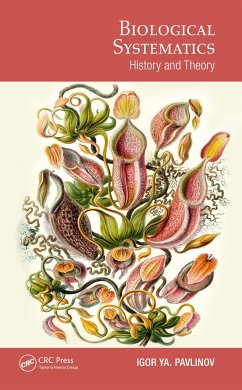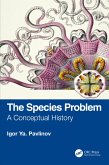- Gebundenes Buch
- Merkliste
- Auf die Merkliste
- Bewerten Bewerten
- Teilen
- Produkt teilen
- Produkterinnerung
- Produkterinnerung
This book presents the theoretical foundations of the biological systematics. The history, structure and main tasks of systematics are summarized. Briefly reviewed are the philosophical foundations of systematics and the structure and content of taxonomic theories.
Andere Kunden interessierten sich auch für
![Biological Systematics Biological Systematics]() Igor PavlinovBiological Systematics47,99 €
Igor PavlinovBiological Systematics47,99 €![The Species Problem The Species Problem]() Igor Ya. PavlinovThe Species Problem126,99 €
Igor Ya. PavlinovThe Species Problem126,99 €![What, if anything, are species? What, if anything, are species?]() Brent D. MishlerWhat, if anything, are species?55,99 €
Brent D. MishlerWhat, if anything, are species?55,99 €![What, if anything, are species? What, if anything, are species?]() Brent D. MishlerWhat, if anything, are species?208,99 €
Brent D. MishlerWhat, if anything, are species?208,99 €![Greenhouse Pest Management Greenhouse Pest Management]() Raymond A. CloydGreenhouse Pest Management68,99 €
Raymond A. CloydGreenhouse Pest Management68,99 €![Species Species]() John S. WilkinsSpecies72,99 €
John S. WilkinsSpecies72,99 €![Species Problems and Beyond Species Problems and Beyond]() Species Problems and Beyond56,99 €
Species Problems and Beyond56,99 €-
-
-
This book presents the theoretical foundations of the biological systematics. The history, structure and main tasks of systematics are summarized. Briefly reviewed are the philosophical foundations of systematics and the structure and content of taxonomic theories.
Hinweis: Dieser Artikel kann nur an eine deutsche Lieferadresse ausgeliefert werden.
Hinweis: Dieser Artikel kann nur an eine deutsche Lieferadresse ausgeliefert werden.
Produktdetails
- Produktdetails
- Species and Systematics
- Verlag: Taylor & Francis Ltd
- Seitenzahl: 256
- Erscheinungstermin: 26. März 2021
- Englisch
- Abmessung: 234mm x 156mm x 16mm
- Gewicht: 550g
- ISBN-13: 9780367654450
- ISBN-10: 0367654458
- Artikelnr.: 61356169
- Herstellerkennzeichnung
- Libri GmbH
- Europaallee 1
- 36244 Bad Hersfeld
- gpsr@libri.de
- Species and Systematics
- Verlag: Taylor & Francis Ltd
- Seitenzahl: 256
- Erscheinungstermin: 26. März 2021
- Englisch
- Abmessung: 234mm x 156mm x 16mm
- Gewicht: 550g
- ISBN-13: 9780367654450
- ISBN-10: 0367654458
- Artikelnr.: 61356169
- Herstellerkennzeichnung
- Libri GmbH
- Europaallee 1
- 36244 Bad Hersfeld
- gpsr@libri.de
Igor Ya. Pavlinov is at the Zoological Museum of the Moscow Lomonosov State University in Moscow, Russia.
Table of contents
Preface
Introduction
Chapter 1. A brief outline of systematics
1.1. What is the Natural System
1.2. What is biological systematics
1.2.1. The structure of systematics
1.2.2. What does systematics study
1.2.3. How does systematics study
1.2.4. What does systematics study for
Chapter 2. Conceptual history of systematics
2.1. Some preliminary considerations
2.1.1. How conceptual history can be written
2.1.2. History of systematics as an evolutionary process
2.1.3. Major steps in the history of systematics
2.2. Prehistory of systematics
2.2.1. An initial step: Folk systematics
2.2.2. Becoming aware of The Method
2.2.3. The Herbal Epoch
2.3. The beginning of systematics: Scholastic revolution
2.3.1. Major features
2.3.2. Major stages
2.4. Emergence of biological systematics: Anti-scholastic revolution
2.4.1. Major non-scholastic motives
2.4.2. The natural systematics
2.4.3. The origin of typology
2.4.4. The "taxonomic esotericism"
2.5. A step forward: Evolutionary revolution
2.5.1. First ideas
2.5.2. First debates
2.6. A step aside: Positivist revolution
2.7. Homage to metaphysics: Post-positivist revolution
Chapter 3. Some philosophical considerations
3.1. Classical and non-classical science
3.2. Cognitive situation
3.2.1. Cognitive triangle
3.2.2. Conceptual space
3.2.3. Conceptual pyramid
3.3. Some cognitive regulators
3.3.1. Between Umgebung and Umwelts
3.3.2. Between holism and reductionism
3.3.3. Between realism and nominalism
3.3.4. Between monism and pluralism
3.4. Knowledge as an information model
3.5. The logical bases
3.6. Argumentation schemes
3.7. Methodologies and methods
3.7.1. Scientific status of methodologies and methods
3.7.2. Basic methods
Chapter 4. An outline of taxonomic theory
4.1. Taxonomic theory as a quasi-axiomatics
4.1.1. General and particular taxonomic theories
4.1.2. Basic quasi-axioms and principles
4.2. Defining basic notions: Two study cases
4.2.1. Taxonomic reality
4.2.2. Classification system
Chapter 5. Major research programs in systematics
5.1. The phenetic program
5.2. The rational systematics
5.2.1. The onto-rational program
5.2.2. The episto-rational program
5.3. The numerical program
5.3.1. Major features
5.3.2. Two basic versions
5.3.3. Basic controversies
5.4. The typological program
5.4.1. Major features
5.4.2. Contemporary developments
5.5. The biomorphic program
5.6. The biosystematic program
5.7. The phylogenetic program
5.7.1. Major features
5.7.2. Evolutionary taxonomy
5.7.3. Cladistic systematics
5.8. The evolutionary ontogenetic program?
Chapter 6. Taxonomic puzzles
6.1. Between natural and artificial classifications
6.2. Between taxon and character
6.3. Hierarchies: To rank or not to rank?
6.4. Between similarity and kinship
6.5. What is the (arche)type?
6.6. Homology, an unresolved problem
6.7. An undiscoverable essence of species?
References
Preface
Introduction
Chapter 1. A brief outline of systematics
1.1. What is the Natural System
1.2. What is biological systematics
1.2.1. The structure of systematics
1.2.2. What does systematics study
1.2.3. How does systematics study
1.2.4. What does systematics study for
Chapter 2. Conceptual history of systematics
2.1. Some preliminary considerations
2.1.1. How conceptual history can be written
2.1.2. History of systematics as an evolutionary process
2.1.3. Major steps in the history of systematics
2.2. Prehistory of systematics
2.2.1. An initial step: Folk systematics
2.2.2. Becoming aware of The Method
2.2.3. The Herbal Epoch
2.3. The beginning of systematics: Scholastic revolution
2.3.1. Major features
2.3.2. Major stages
2.4. Emergence of biological systematics: Anti-scholastic revolution
2.4.1. Major non-scholastic motives
2.4.2. The natural systematics
2.4.3. The origin of typology
2.4.4. The "taxonomic esotericism"
2.5. A step forward: Evolutionary revolution
2.5.1. First ideas
2.5.2. First debates
2.6. A step aside: Positivist revolution
2.7. Homage to metaphysics: Post-positivist revolution
Chapter 3. Some philosophical considerations
3.1. Classical and non-classical science
3.2. Cognitive situation
3.2.1. Cognitive triangle
3.2.2. Conceptual space
3.2.3. Conceptual pyramid
3.3. Some cognitive regulators
3.3.1. Between Umgebung and Umwelts
3.3.2. Between holism and reductionism
3.3.3. Between realism and nominalism
3.3.4. Between monism and pluralism
3.4. Knowledge as an information model
3.5. The logical bases
3.6. Argumentation schemes
3.7. Methodologies and methods
3.7.1. Scientific status of methodologies and methods
3.7.2. Basic methods
Chapter 4. An outline of taxonomic theory
4.1. Taxonomic theory as a quasi-axiomatics
4.1.1. General and particular taxonomic theories
4.1.2. Basic quasi-axioms and principles
4.2. Defining basic notions: Two study cases
4.2.1. Taxonomic reality
4.2.2. Classification system
Chapter 5. Major research programs in systematics
5.1. The phenetic program
5.2. The rational systematics
5.2.1. The onto-rational program
5.2.2. The episto-rational program
5.3. The numerical program
5.3.1. Major features
5.3.2. Two basic versions
5.3.3. Basic controversies
5.4. The typological program
5.4.1. Major features
5.4.2. Contemporary developments
5.5. The biomorphic program
5.6. The biosystematic program
5.7. The phylogenetic program
5.7.1. Major features
5.7.2. Evolutionary taxonomy
5.7.3. Cladistic systematics
5.8. The evolutionary ontogenetic program?
Chapter 6. Taxonomic puzzles
6.1. Between natural and artificial classifications
6.2. Between taxon and character
6.3. Hierarchies: To rank or not to rank?
6.4. Between similarity and kinship
6.5. What is the (arche)type?
6.6. Homology, an unresolved problem
6.7. An undiscoverable essence of species?
References
Table of contents
Preface
Introduction
Chapter 1. A brief outline of systematics
1.1. What is the Natural System
1.2. What is biological systematics
1.2.1. The structure of systematics
1.2.2. What does systematics study
1.2.3. How does systematics study
1.2.4. What does systematics study for
Chapter 2. Conceptual history of systematics
2.1. Some preliminary considerations
2.1.1. How conceptual history can be written
2.1.2. History of systematics as an evolutionary process
2.1.3. Major steps in the history of systematics
2.2. Prehistory of systematics
2.2.1. An initial step: Folk systematics
2.2.2. Becoming aware of The Method
2.2.3. The Herbal Epoch
2.3. The beginning of systematics: Scholastic revolution
2.3.1. Major features
2.3.2. Major stages
2.4. Emergence of biological systematics: Anti-scholastic revolution
2.4.1. Major non-scholastic motives
2.4.2. The natural systematics
2.4.3. The origin of typology
2.4.4. The "taxonomic esotericism"
2.5. A step forward: Evolutionary revolution
2.5.1. First ideas
2.5.2. First debates
2.6. A step aside: Positivist revolution
2.7. Homage to metaphysics: Post-positivist revolution
Chapter 3. Some philosophical considerations
3.1. Classical and non-classical science
3.2. Cognitive situation
3.2.1. Cognitive triangle
3.2.2. Conceptual space
3.2.3. Conceptual pyramid
3.3. Some cognitive regulators
3.3.1. Between Umgebung and Umwelts
3.3.2. Between holism and reductionism
3.3.3. Between realism and nominalism
3.3.4. Between monism and pluralism
3.4. Knowledge as an information model
3.5. The logical bases
3.6. Argumentation schemes
3.7. Methodologies and methods
3.7.1. Scientific status of methodologies and methods
3.7.2. Basic methods
Chapter 4. An outline of taxonomic theory
4.1. Taxonomic theory as a quasi-axiomatics
4.1.1. General and particular taxonomic theories
4.1.2. Basic quasi-axioms and principles
4.2. Defining basic notions: Two study cases
4.2.1. Taxonomic reality
4.2.2. Classification system
Chapter 5. Major research programs in systematics
5.1. The phenetic program
5.2. The rational systematics
5.2.1. The onto-rational program
5.2.2. The episto-rational program
5.3. The numerical program
5.3.1. Major features
5.3.2. Two basic versions
5.3.3. Basic controversies
5.4. The typological program
5.4.1. Major features
5.4.2. Contemporary developments
5.5. The biomorphic program
5.6. The biosystematic program
5.7. The phylogenetic program
5.7.1. Major features
5.7.2. Evolutionary taxonomy
5.7.3. Cladistic systematics
5.8. The evolutionary ontogenetic program?
Chapter 6. Taxonomic puzzles
6.1. Between natural and artificial classifications
6.2. Between taxon and character
6.3. Hierarchies: To rank or not to rank?
6.4. Between similarity and kinship
6.5. What is the (arche)type?
6.6. Homology, an unresolved problem
6.7. An undiscoverable essence of species?
References
Preface
Introduction
Chapter 1. A brief outline of systematics
1.1. What is the Natural System
1.2. What is biological systematics
1.2.1. The structure of systematics
1.2.2. What does systematics study
1.2.3. How does systematics study
1.2.4. What does systematics study for
Chapter 2. Conceptual history of systematics
2.1. Some preliminary considerations
2.1.1. How conceptual history can be written
2.1.2. History of systematics as an evolutionary process
2.1.3. Major steps in the history of systematics
2.2. Prehistory of systematics
2.2.1. An initial step: Folk systematics
2.2.2. Becoming aware of The Method
2.2.3. The Herbal Epoch
2.3. The beginning of systematics: Scholastic revolution
2.3.1. Major features
2.3.2. Major stages
2.4. Emergence of biological systematics: Anti-scholastic revolution
2.4.1. Major non-scholastic motives
2.4.2. The natural systematics
2.4.3. The origin of typology
2.4.4. The "taxonomic esotericism"
2.5. A step forward: Evolutionary revolution
2.5.1. First ideas
2.5.2. First debates
2.6. A step aside: Positivist revolution
2.7. Homage to metaphysics: Post-positivist revolution
Chapter 3. Some philosophical considerations
3.1. Classical and non-classical science
3.2. Cognitive situation
3.2.1. Cognitive triangle
3.2.2. Conceptual space
3.2.3. Conceptual pyramid
3.3. Some cognitive regulators
3.3.1. Between Umgebung and Umwelts
3.3.2. Between holism and reductionism
3.3.3. Between realism and nominalism
3.3.4. Between monism and pluralism
3.4. Knowledge as an information model
3.5. The logical bases
3.6. Argumentation schemes
3.7. Methodologies and methods
3.7.1. Scientific status of methodologies and methods
3.7.2. Basic methods
Chapter 4. An outline of taxonomic theory
4.1. Taxonomic theory as a quasi-axiomatics
4.1.1. General and particular taxonomic theories
4.1.2. Basic quasi-axioms and principles
4.2. Defining basic notions: Two study cases
4.2.1. Taxonomic reality
4.2.2. Classification system
Chapter 5. Major research programs in systematics
5.1. The phenetic program
5.2. The rational systematics
5.2.1. The onto-rational program
5.2.2. The episto-rational program
5.3. The numerical program
5.3.1. Major features
5.3.2. Two basic versions
5.3.3. Basic controversies
5.4. The typological program
5.4.1. Major features
5.4.2. Contemporary developments
5.5. The biomorphic program
5.6. The biosystematic program
5.7. The phylogenetic program
5.7.1. Major features
5.7.2. Evolutionary taxonomy
5.7.3. Cladistic systematics
5.8. The evolutionary ontogenetic program?
Chapter 6. Taxonomic puzzles
6.1. Between natural and artificial classifications
6.2. Between taxon and character
6.3. Hierarchies: To rank or not to rank?
6.4. Between similarity and kinship
6.5. What is the (arche)type?
6.6. Homology, an unresolved problem
6.7. An undiscoverable essence of species?
References
Table of contents
Preface
Introduction
Chapter 1. A brief outline of systematics
1.1. What is the Natural System
1.2. What is biological systematics
1.2.1. The structure of systematics
1.2.2. What does systematics study
1.2.3. How does systematics study
1.2.4. What does systematics study for
Chapter 2. Conceptual history of systematics
2.1. Some preliminary considerations
2.1.1. How conceptual history can be written
2.1.2. History of systematics as an evolutionary process
2.1.3. Major steps in the history of systematics
2.2. Prehistory of systematics
2.2.1. An initial step: Folk systematics
2.2.2. Becoming aware of The Method
2.2.3. The Herbal Epoch
2.3. The beginning of systematics: Scholastic revolution
2.3.1. Major features
2.3.2. Major stages
2.4. Emergence of biological systematics: Anti-scholastic revolution
2.4.1. Major non-scholastic motives
2.4.2. The natural systematics
2.4.3. The origin of typology
2.4.4. The "taxonomic esotericism"
2.5. A step forward: Evolutionary revolution
2.5.1. First ideas
2.5.2. First debates
2.6. A step aside: Positivist revolution
2.7. Homage to metaphysics: Post-positivist revolution
Chapter 3. Some philosophical considerations
3.1. Classical and non-classical science
3.2. Cognitive situation
3.2.1. Cognitive triangle
3.2.2. Conceptual space
3.2.3. Conceptual pyramid
3.3. Some cognitive regulators
3.3.1. Between Umgebung and Umwelts
3.3.2. Between holism and reductionism
3.3.3. Between realism and nominalism
3.3.4. Between monism and pluralism
3.4. Knowledge as an information model
3.5. The logical bases
3.6. Argumentation schemes
3.7. Methodologies and methods
3.7.1. Scientific status of methodologies and methods
3.7.2. Basic methods
Chapter 4. An outline of taxonomic theory
4.1. Taxonomic theory as a quasi-axiomatics
4.1.1. General and particular taxonomic theories
4.1.2. Basic quasi-axioms and principles
4.2. Defining basic notions: Two study cases
4.2.1. Taxonomic reality
4.2.2. Classification system
Chapter 5. Major research programs in systematics
5.1. The phenetic program
5.2. The rational systematics
5.2.1. The onto-rational program
5.2.2. The episto-rational program
5.3. The numerical program
5.3.1. Major features
5.3.2. Two basic versions
5.3.3. Basic controversies
5.4. The typological program
5.4.1. Major features
5.4.2. Contemporary developments
5.5. The biomorphic program
5.6. The biosystematic program
5.7. The phylogenetic program
5.7.1. Major features
5.7.2. Evolutionary taxonomy
5.7.3. Cladistic systematics
5.8. The evolutionary ontogenetic program?
Chapter 6. Taxonomic puzzles
6.1. Between natural and artificial classifications
6.2. Between taxon and character
6.3. Hierarchies: To rank or not to rank?
6.4. Between similarity and kinship
6.5. What is the (arche)type?
6.6. Homology, an unresolved problem
6.7. An undiscoverable essence of species?
References
Preface
Introduction
Chapter 1. A brief outline of systematics
1.1. What is the Natural System
1.2. What is biological systematics
1.2.1. The structure of systematics
1.2.2. What does systematics study
1.2.3. How does systematics study
1.2.4. What does systematics study for
Chapter 2. Conceptual history of systematics
2.1. Some preliminary considerations
2.1.1. How conceptual history can be written
2.1.2. History of systematics as an evolutionary process
2.1.3. Major steps in the history of systematics
2.2. Prehistory of systematics
2.2.1. An initial step: Folk systematics
2.2.2. Becoming aware of The Method
2.2.3. The Herbal Epoch
2.3. The beginning of systematics: Scholastic revolution
2.3.1. Major features
2.3.2. Major stages
2.4. Emergence of biological systematics: Anti-scholastic revolution
2.4.1. Major non-scholastic motives
2.4.2. The natural systematics
2.4.3. The origin of typology
2.4.4. The "taxonomic esotericism"
2.5. A step forward: Evolutionary revolution
2.5.1. First ideas
2.5.2. First debates
2.6. A step aside: Positivist revolution
2.7. Homage to metaphysics: Post-positivist revolution
Chapter 3. Some philosophical considerations
3.1. Classical and non-classical science
3.2. Cognitive situation
3.2.1. Cognitive triangle
3.2.2. Conceptual space
3.2.3. Conceptual pyramid
3.3. Some cognitive regulators
3.3.1. Between Umgebung and Umwelts
3.3.2. Between holism and reductionism
3.3.3. Between realism and nominalism
3.3.4. Between monism and pluralism
3.4. Knowledge as an information model
3.5. The logical bases
3.6. Argumentation schemes
3.7. Methodologies and methods
3.7.1. Scientific status of methodologies and methods
3.7.2. Basic methods
Chapter 4. An outline of taxonomic theory
4.1. Taxonomic theory as a quasi-axiomatics
4.1.1. General and particular taxonomic theories
4.1.2. Basic quasi-axioms and principles
4.2. Defining basic notions: Two study cases
4.2.1. Taxonomic reality
4.2.2. Classification system
Chapter 5. Major research programs in systematics
5.1. The phenetic program
5.2. The rational systematics
5.2.1. The onto-rational program
5.2.2. The episto-rational program
5.3. The numerical program
5.3.1. Major features
5.3.2. Two basic versions
5.3.3. Basic controversies
5.4. The typological program
5.4.1. Major features
5.4.2. Contemporary developments
5.5. The biomorphic program
5.6. The biosystematic program
5.7. The phylogenetic program
5.7.1. Major features
5.7.2. Evolutionary taxonomy
5.7.3. Cladistic systematics
5.8. The evolutionary ontogenetic program?
Chapter 6. Taxonomic puzzles
6.1. Between natural and artificial classifications
6.2. Between taxon and character
6.3. Hierarchies: To rank or not to rank?
6.4. Between similarity and kinship
6.5. What is the (arche)type?
6.6. Homology, an unresolved problem
6.7. An undiscoverable essence of species?
References
Table of contents
Preface
Introduction
Chapter 1. A brief outline of systematics
1.1. What is the Natural System
1.2. What is biological systematics
1.2.1. The structure of systematics
1.2.2. What does systematics study
1.2.3. How does systematics study
1.2.4. What does systematics study for
Chapter 2. Conceptual history of systematics
2.1. Some preliminary considerations
2.1.1. How conceptual history can be written
2.1.2. History of systematics as an evolutionary process
2.1.3. Major steps in the history of systematics
2.2. Prehistory of systematics
2.2.1. An initial step: Folk systematics
2.2.2. Becoming aware of The Method
2.2.3. The Herbal Epoch
2.3. The beginning of systematics: Scholastic revolution
2.3.1. Major features
2.3.2. Major stages
2.4. Emergence of biological systematics: Anti-scholastic revolution
2.4.1. Major non-scholastic motives
2.4.2. The natural systematics
2.4.3. The origin of typology
2.4.4. The "taxonomic esotericism"
2.5. A step forward: Evolutionary revolution
2.5.1. First ideas
2.5.2. First debates
2.6. A step aside: Positivist revolution
2.7. Homage to metaphysics: Post-positivist revolution
Chapter 3. Some philosophical considerations
3.1. Classical and non-classical science
3.2. Cognitive situation
3.2.1. Cognitive triangle
3.2.2. Conceptual space
3.2.3. Conceptual pyramid
3.3. Some cognitive regulators
3.3.1. Between Umgebung and Umwelts
3.3.2. Between holism and reductionism
3.3.3. Between realism and nominalism
3.3.4. Between monism and pluralism
3.4. Knowledge as an information model
3.5. The logical bases
3.6. Argumentation schemes
3.7. Methodologies and methods
3.7.1. Scientific status of methodologies and methods
3.7.2. Basic methods
Chapter 4. An outline of taxonomic theory
4.1. Taxonomic theory as a quasi-axiomatics
4.1.1. General and particular taxonomic theories
4.1.2. Basic quasi-axioms and principles
4.2. Defining basic notions: Two study cases
4.2.1. Taxonomic reality
4.2.2. Classification system
Chapter 5. Major research programs in systematics
5.1. The phenetic program
5.2. The rational systematics
5.2.1. The onto-rational program
5.2.2. The episto-rational program
5.3. The numerical program
5.3.1. Major features
5.3.2. Two basic versions
5.3.3. Basic controversies
5.4. The typological program
5.4.1. Major features
5.4.2. Contemporary developments
5.5. The biomorphic program
5.6. The biosystematic program
5.7. The phylogenetic program
5.7.1. Major features
5.7.2. Evolutionary taxonomy
5.7.3. Cladistic systematics
5.8. The evolutionary ontogenetic program?
Chapter 6. Taxonomic puzzles
6.1. Between natural and artificial classifications
6.2. Between taxon and character
6.3. Hierarchies: To rank or not to rank?
6.4. Between similarity and kinship
6.5. What is the (arche)type?
6.6. Homology, an unresolved problem
6.7. An undiscoverable essence of species?
References
Preface
Introduction
Chapter 1. A brief outline of systematics
1.1. What is the Natural System
1.2. What is biological systematics
1.2.1. The structure of systematics
1.2.2. What does systematics study
1.2.3. How does systematics study
1.2.4. What does systematics study for
Chapter 2. Conceptual history of systematics
2.1. Some preliminary considerations
2.1.1. How conceptual history can be written
2.1.2. History of systematics as an evolutionary process
2.1.3. Major steps in the history of systematics
2.2. Prehistory of systematics
2.2.1. An initial step: Folk systematics
2.2.2. Becoming aware of The Method
2.2.3. The Herbal Epoch
2.3. The beginning of systematics: Scholastic revolution
2.3.1. Major features
2.3.2. Major stages
2.4. Emergence of biological systematics: Anti-scholastic revolution
2.4.1. Major non-scholastic motives
2.4.2. The natural systematics
2.4.3. The origin of typology
2.4.4. The "taxonomic esotericism"
2.5. A step forward: Evolutionary revolution
2.5.1. First ideas
2.5.2. First debates
2.6. A step aside: Positivist revolution
2.7. Homage to metaphysics: Post-positivist revolution
Chapter 3. Some philosophical considerations
3.1. Classical and non-classical science
3.2. Cognitive situation
3.2.1. Cognitive triangle
3.2.2. Conceptual space
3.2.3. Conceptual pyramid
3.3. Some cognitive regulators
3.3.1. Between Umgebung and Umwelts
3.3.2. Between holism and reductionism
3.3.3. Between realism and nominalism
3.3.4. Between monism and pluralism
3.4. Knowledge as an information model
3.5. The logical bases
3.6. Argumentation schemes
3.7. Methodologies and methods
3.7.1. Scientific status of methodologies and methods
3.7.2. Basic methods
Chapter 4. An outline of taxonomic theory
4.1. Taxonomic theory as a quasi-axiomatics
4.1.1. General and particular taxonomic theories
4.1.2. Basic quasi-axioms and principles
4.2. Defining basic notions: Two study cases
4.2.1. Taxonomic reality
4.2.2. Classification system
Chapter 5. Major research programs in systematics
5.1. The phenetic program
5.2. The rational systematics
5.2.1. The onto-rational program
5.2.2. The episto-rational program
5.3. The numerical program
5.3.1. Major features
5.3.2. Two basic versions
5.3.3. Basic controversies
5.4. The typological program
5.4.1. Major features
5.4.2. Contemporary developments
5.5. The biomorphic program
5.6. The biosystematic program
5.7. The phylogenetic program
5.7.1. Major features
5.7.2. Evolutionary taxonomy
5.7.3. Cladistic systematics
5.8. The evolutionary ontogenetic program?
Chapter 6. Taxonomic puzzles
6.1. Between natural and artificial classifications
6.2. Between taxon and character
6.3. Hierarchies: To rank or not to rank?
6.4. Between similarity and kinship
6.5. What is the (arche)type?
6.6. Homology, an unresolved problem
6.7. An undiscoverable essence of species?
References









